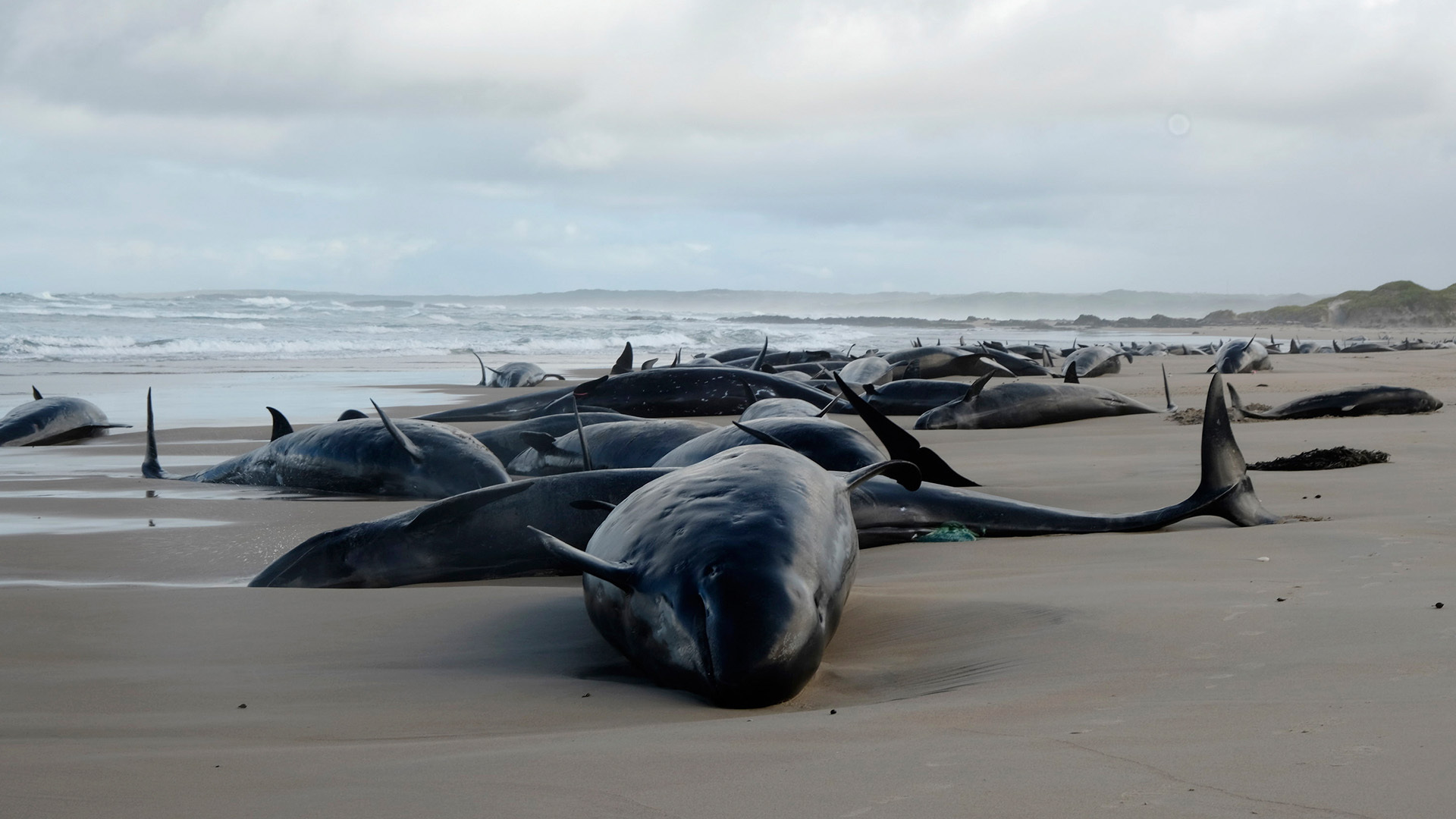
Stranded false killer whales in Tasmania likely unable to be rescued
By Craig Nigrelli (Reporter), Brock Koller (Senior Producer), Kaleb Gillespie (Video Editor)
- Rescuers are on the scene of a very dire situation on a remote beach in Tasmania. More than 130 false killer whales have washed ashore.
- Experts are on location and have been trying to save them, with little success so far.
- Rough seas, including surging and thrashing water, are keeping the rescuers from floating them back out to their habitat. As a result, the beached whales will have to be euthanized, so they do not continue to suffer.
Full Story
A number of false killer whales have washed ashore and are stranded on a remote beach in the Australian state of Tasmania. Experts now say they have given up hope of rescuing the 157 creatures.
Media Landscape
See how news outlets across the political spectrum are covering this story. Learn moreBias Summary
- More than 150 false killer whales are stranded on a beach in Tasmania, with rescue teams working to save the survivors, according to Australian environment officials.
- Brendon Clark, a liaison officer at the Tasmania Parks and Wildlife Service, stated that only 90 of the 157 beached whales appeared to still be alive.
- Challenges including the inaccessibility of the beach and ocean conditions are complicating the rescue response, as noted by the Department of Natural Resources and Environment Tasmania.
- Local resident Jocelyn Flint reported that her son discovered the stranded whales around midnight, stating, "They’re just dying, they’ve sunk down in the sand."
- No summary available because of a lack of coverage.
- A pod of 157 false killer whales has stranded on a beach in Tasmania, with approximately 90 still alive as of Feb. 19, according to environment officials.
- Brendon Clark, a state wildlife officer, mentioned the difficulty of refloating the surviving false killer whales that can weigh over one ton.
Bias Comparison
Bias Distribution
Left
Right
Untracked Bias
Where specifically are the whales stranded?
The Department of Natural Resources and Environment Tasmania said veterinarians are on the scene near the Arthur River, where the whales are beached. False killer whales get their name because of the shape of their skull.

Download the SAN app today to stay up-to-date with Unbiased. Straight Facts™.
Point phone camera here
What are the major difficulties with rescuing and treating them?
The lead rescuer said unfavorable ocean and weather conditions are preventing the whales from being rescued and re-floated, as the whales keep getting stranded due to surging and thrashing water. In addition, the inaccessibility of the beach and difficulty getting specialized equipment to the area are complicating matters.
What will happen to the whales from here?
Marine biologist Kris Carlyon said the longer the animals are stranded, the longer they are suffering. All rescue options have been unsuccessful, and the workers will have to euthanize them.
The department says there were 136 survivors the morning of Wednesday, Feb. 19, but that assessment then dropped to 90 in just a few hours. The department has not given a reason why the whales initially became stranded. Possibilities include disorientation induced by loud noises, illness, injury fleeing predators and severe weather. Some have been on the beach for at least two days.
Get up to speed on the stories leading the day every weekday morning. Sign up for the newsletter today!
Learn more about our emails. Unsubscribe anytime.
By entering your email, you agree to the Terms & Conditions and acknowledge the Privacy Policy.
How big are they?
The young whales weigh just over 1,000 pounds, while the largest weigh more than 3 tons.
A helicopter surveillance of the area showed no additional whales that are part of this stranded pod within a several-mile radius.
[Craig Nigrelli]
A VERY SAD SITE ALONG A REMOTE BEACH ON AUSTRALIA’S STATE, TASMANIA.
157 FALSE KILLER WHALES HAVE WASHED ASHORED AND ARE STRANDED. EXPERTS NOW SAY THEY HAVE GIVEN UP HOPE OF RESCUING THEM.
THE DEPARTMENT OF NATURAL RESOURCES AND ENVIRONMENT SAYS VETERINARIANS ARE ON THE SCENE, NEAR THE ARTHUR RIVER, WHERE THE WHALES ARE BEACHED. FALSE KILLER WHALES GET THEIR NAME BECAUSE OF THE SHAPE OF THEIR SKULL, THAT IS SIMILAR TO THAT OF THE KILLER WHALE.
THE LEAD RESCUER SAYS UNFAVORABLE OCEAN AND WEATHER CONDITIONS ARE PREVENTING THE WHALES FROM BEING RESCUED AND REFLOATED, AS THE WHALES KEEP GETTING STRANDED, DUE TO THE SURGING AND THRASHING WATER.
IN ADDITION, THE INACCESSIBILITY OF THE BEACH AND DIFFICULTY GETTING SPECIALIZED EQUIPMENT TO THE AREA ARE COMPLICATING MATTERS.
MARINE BIOLOGIST KRIS CARLYON SAID “ THE LONGER THESE ANIMALS ARE OUT STRANDED, THE LONGER THEY ARE SUFFERING. ALL ALTERNATIVE OPTIONS HAVE BEEN UNSUCCESSFUL. “ AS A RESULT, WORKERS WILL HAVE TO EUTHANIZE THEM.
THE DEPARTMENT SAYS THERE WERE 136 SURVIVORS THIS MORNING BUT THAT ASSESSMENT THEN DROPPED TO 90 IN JUST A FEW HOURS.
IT HAS NOT GIVEN A REASON OR SPECULATED ON WHY THE WHALES INITIALLY BECAME STRANDED. POSSIBILITIES INCLUDE DISORIENTATION, CAUSED BY LOUD NOISES, ILLNESS, INJURY, FLEEING PREDATORS AND SEVERE WEATHER.
SOME HAVE BEEN ON THE BEACH FOR AT LEAST TWO DAYS.
THE YOUNG WHALES WEIGH JUST OVER 1000 POUNDS, WHILE THE LARGEST, ADULTS, WEIGH MORE THAN THREE TONS.
EXPERTS SAY THIS IS THE FIRST TIME FALSE KILLER WHALES HAVE BEEN STRANDED LIKE THIS IN TASMANIA SINCE 1974. A HELICOPTER SURVEILLANCE OF THE AREA SHOWED NO ADDITIONAL WHALES THAT ARE PART OF THIS STRANDED POD, WITHIN A SEVERAL MILE RADIUS. FOR MORE UNBIASED UPDATES, DOWNLOAD THE STRAIGHT ARROW NEWS APP
Media Landscape
See how news outlets across the political spectrum are covering this story. Learn moreBias Summary
- More than 150 false killer whales are stranded on a beach in Tasmania, with rescue teams working to save the survivors, according to Australian environment officials.
- Brendon Clark, a liaison officer at the Tasmania Parks and Wildlife Service, stated that only 90 of the 157 beached whales appeared to still be alive.
- Challenges including the inaccessibility of the beach and ocean conditions are complicating the rescue response, as noted by the Department of Natural Resources and Environment Tasmania.
- Local resident Jocelyn Flint reported that her son discovered the stranded whales around midnight, stating, "They’re just dying, they’ve sunk down in the sand."
- No summary available because of a lack of coverage.
- A pod of 157 false killer whales has stranded on a beach in Tasmania, with approximately 90 still alive as of Feb. 19, according to environment officials.
- Brendon Clark, a state wildlife officer, mentioned the difficulty of refloating the surviving false killer whales that can weigh over one ton.
Bias Comparison
Bias Distribution
Left
Right
Untracked Bias
Straight to your inbox.
By entering your email, you agree to the Terms & Conditions and acknowledge the Privacy Policy.
MOST POPULAR
-
 Getty Images
Getty Images
‘Mass casualty attack’ plot at Texas high school involving 2 teens thwarted: FBI
Watch 1:1311 hrs ago -

Former NFL punter handcuffed, hauled out by police after MAGA protest
Watch 2:1011 hrs ago -
 AP Images
AP Images
Appeals court won’t reinstate Trump’s birthright citizenship order
Watch 0:3913 hrs ago -
 Getty Images
Getty Images
Veteran federal prosecutor resigns amid pressure to investigate Biden agency
Watch 1:5219 hrs ago




